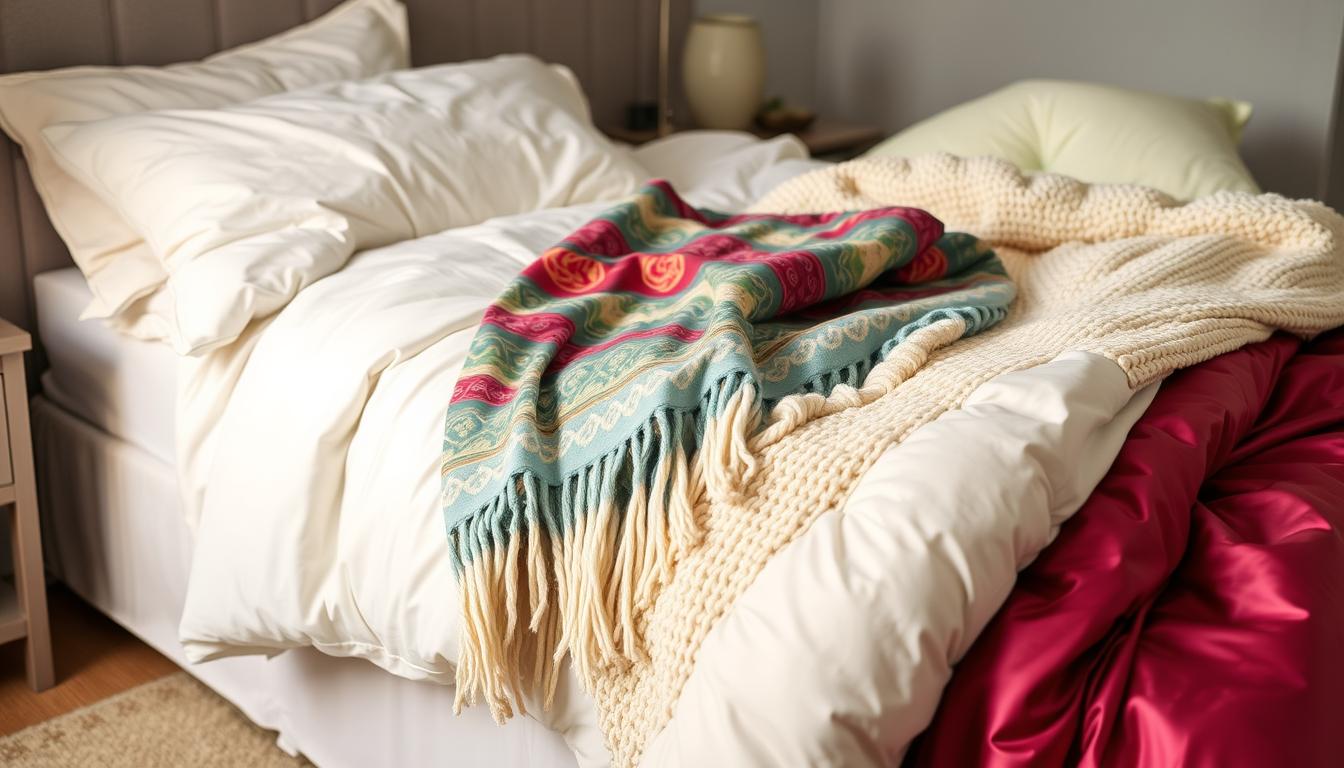Did you know the average person sleeps for about one-third of their life? This means your bed’s comforter is crucial for a good night’s sleep. There are many types of comforters, from down and down alternative to lightweight and heavyweight. Each type meets different sleep needs and preferences.
Contents
- 1 What is a Comforter?
- 2 Different Types of Comforters
- 3 Understanding Down Comforters
- 4 Down Alternative Comforters
- 5 Choosing the Right Comforter Warmth Level
- 6 Comforter Construction
- 7 Choosing the Right Comforter Size
- 8 Different Types of Comforters Available
- 9 Conclusion
- 10 FAQ
- 10.1 What is the difference between a comforter and a duvet insert?
- 10.2 What are the main types of comforter fillings?
- 10.3 What is the difference between duck down and goose down?
- 10.4 What is down alternative and how does it compare to down?
- 10.5 How do I determine the right warmth level for a comforter?
- 10.6 What are the different types of comforter constructions?
- 10.7 How do I choose the right comforter size for my bed?
- 10.8 What other types of comforters are available besides down and down alternative?
Key Takeaways
- Comforters come in a variety of materials, including down, down alternative, and synthetic blends.
- Down comforters offer superior warmth and softness, while down alternative options are often more affordable and hypoallergenic.
- Factors like fill power, construction, and size are important considerations when choosing the right comforter for your bed.
- Comforters can provide different levels of warmth, from lightweight summer options to heavyweight winter choices.
- Proper care and maintenance can help extend the life of your comforter and ensure it continues to provide optimal comfort.
What is a Comforter?
A comforter is a thick, quilted blanket for your bed. It keeps you warm and cozy. It’s similar to a duvet insert, filled with down, feathers, or synthetic fibers.
The main difference is in looks and use. Comforters are colorful and patterned. They don’t need a duvet cover. They have loops for easy attachment to a duvet cover.
Read: Hypoallergenic Comforters for Allergy Sufferers
Comforter vs. Duvet Insert
Duvet inserts are usually white or neutral. Comforters, however, come in many colors and patterns. They’re designed to be used alone, without a duvet cover.
Duvet inserts need a removable cover for washing and style changes. They’re more versatile, letting you easily change your bed’s look.
Both comforters and duvet inserts warm and comfort you. But they differ in appearance and use. Your choice depends on your bedroom style and preference.
“The primary difference between a comforter and a duvet insert is that comforters are available in a wider range of colors and patterns, while duvet inserts are typically white or neutral in color.”
Different Types of Comforters
Down vs. Down Alternative
There are two main types of comforters: down and down alternative. Down comforters are made from the soft, fluffy undercoat of ducks or geese. They are warm and breathable. Down alternative comforters use synthetic materials that act like natural down. They are good for those with allergies or who prefer non-animal fillings.
Both down comforters and down alternative comforters are cozy and warm. The choice between them depends on what you like and how much you want to spend. Down comforters are softer and better at keeping you warm, but they cost more. Down alternative comforters are cheaper and don’t make you allergic.
| Feature | Down Comforter | Down Alternative Comforter |
|---|---|---|
| Fill Material | Duck or goose down | Synthetic fibers (polyester, microfiber) |
| Warmth | Excellent insulation and warmth | Good insulation and warmth, but may require a heavier comforter to achieve the same level |
| Breathability | Highly breathable, allowing for temperature regulation | Less breathable than down, but still offers good airflow |
| Allergens | May cause allergic reactions for some individuals | Hypoallergenic, suitable for those with allergies |
| Cost | Generally more expensive | More affordable |
Choosing between down comforters and down alternative comforters depends on your needs and budget. Both are cozy and comfortable. Think about what you need to pick the right comforter for your bed.
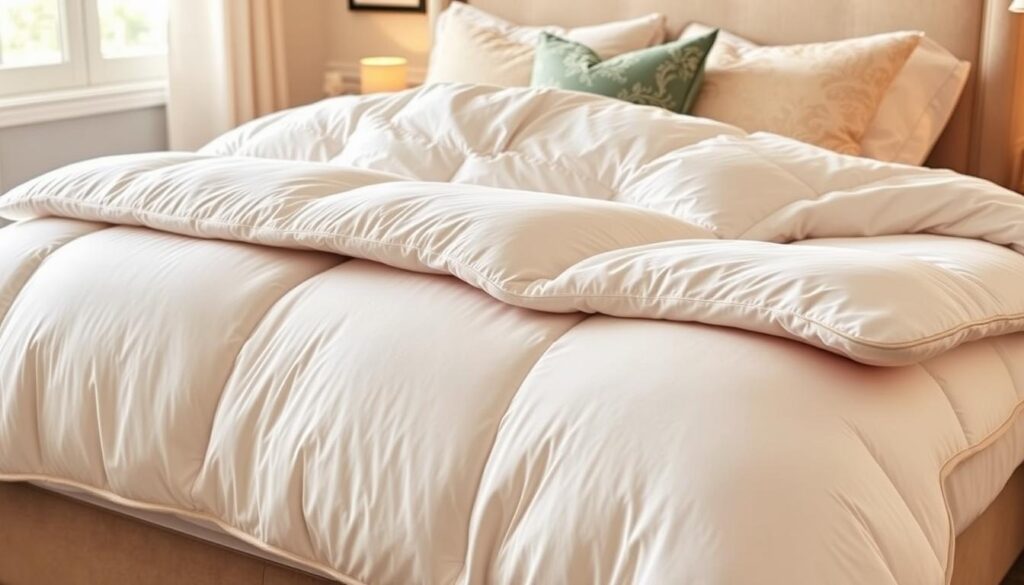
Understanding Down Comforters
Down comforters are the best for bedding. They are warm, cozy, and light but still breathable. Down comes from the fluffy clusters under ducks or geese’s belly feathers. With the right care, down comforters last a long time, making them a great choice for your bed.
Duck down and goose down look similar at first glance. But, goose down has a higher fill power than duck down. The down from colder places, like Europe, is also bigger and fluffier.
Ultra-soft and superfine, Hungarian goose down is the best on the market. It’s incredibly light but still keeps you warm and comfortable. Hungarian goose down is the top choice for down comforters.
“Down is Mother Nature’s most efficient insulator, making it one of the finest materials for your bedding.”
| Down Type | Fill Power | Qualities |
|---|---|---|
| Duck Down | 600-700 | Affordable, widely available |
| Goose Down | 700-900 | Higher fill power, superior insulation |
| Hungarian Goose Down | 800-900+ | Exceptionally light, incredibly warm |
Down Alternative Comforters
Looking for a down-free or budget-friendly option? Down alternative comforters are a great choice. They use synthetic fill, like PrimaLoft® or LoftAIRE™, that feels like natural down. They’re perfect for those with down allergies, offering warmth without irritation.
PrimaLoft® is a top-notch hypoallergenic fill. It’s a fine polyester microfiber that keeps you warm, dries moisture, and blocks cold. LoftAIRE™ is our exclusive synthetic microfiber. It’s as warm and insulating as natural down.
- Down alternative comforters are machine washable, making them easy to care for.
- They come in various fillings, including PrimaLoft®, LoftAIRE™, and 100% polyester, to fit different tastes and budgets.
- The synthetic fills in down alternative comforters offer the cozy warmth of natural down, without allergy worries.
Need a hypoallergenic or affordable option? Down alternative comforters are a versatile and practical choice for your bedding.
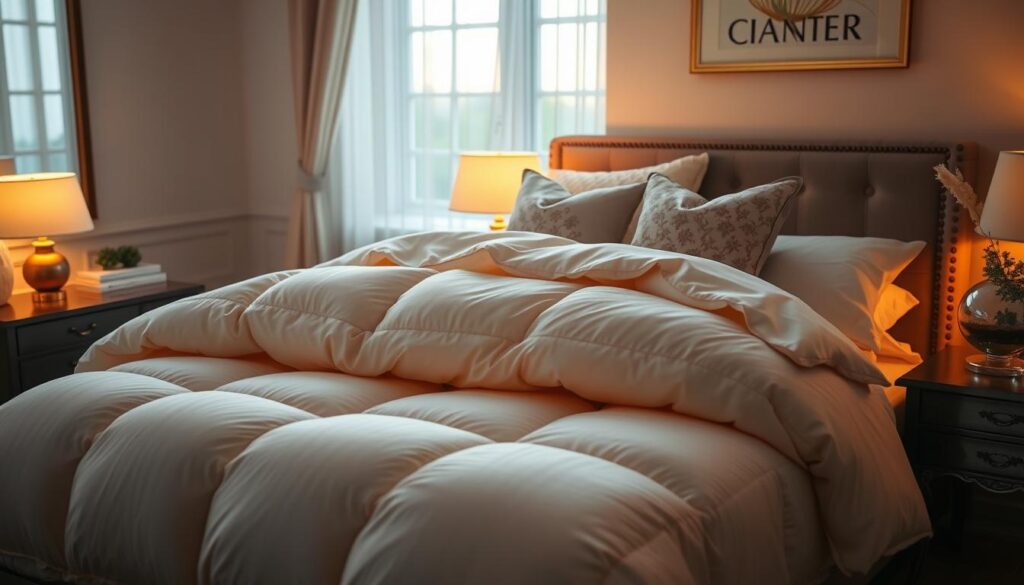
Choosing the Right Comforter Warmth Level
Comforters come in different warmth levels, and what’s right for you depends on your personal taste. Understanding how a comforter keeps you warm is key. This is where fill power plays a big role.
Understanding Fill Power
Fill power shows how warm and fluffy a down comforter is. It measures how much air one ounce of down can trap. Comforters with higher fill power are warmer and lighter, making them great for those who want a lightweight comforter but still need warmth.
Our down comforters have fill powers from 500 to 750. This means we have options for everyone, from those who need a cooling comforter for summer to those who want an all-season comforter for colder months. We ensure you find the perfect comforter warmth level for a cozy night’s sleep.
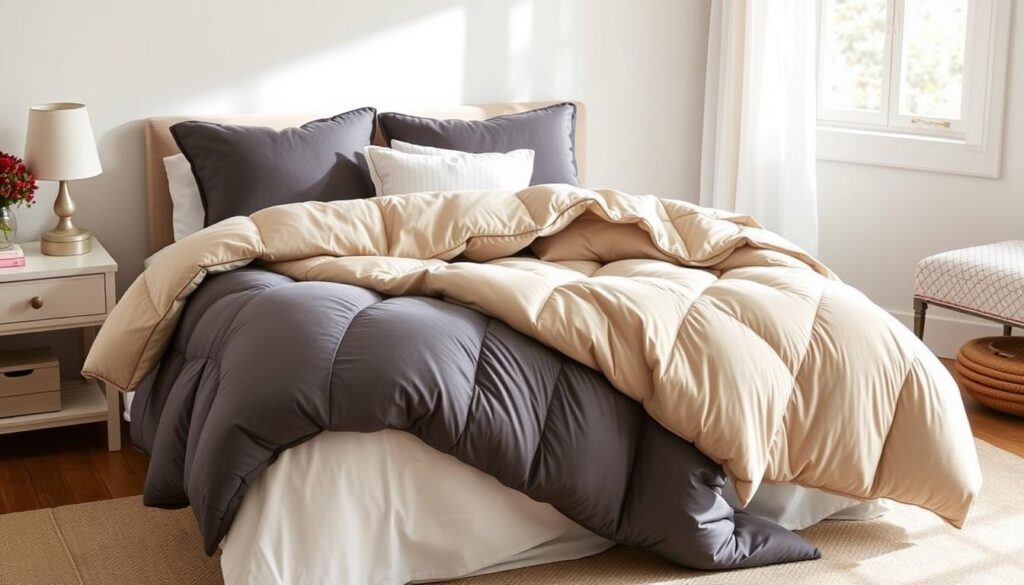
“Having the right comforter warmth level is essential for a good night’s sleep. With our wide range of fill powers, you’ll find the perfect balance of comfort and insulation.”
Comforter Construction
The way a comforter is made is just as important as what’s inside. The best ones spread warmth evenly across the bed. There are two main ways to make down comforters: baffle box and sewn-through box.
Baffle Box vs. Sewn-Through Box
Baffle box comforters have pockets for fill material, separated by fabric walls. This design keeps the fill even, so you don’t feel cold spots. Sewn-through box comforters, on the other hand, have pockets made by stitching the top and bottom fabrics together. They look puffy and pillow-like from the top.
Choosing between baffle box and sewn-through box depends on what you like. But baffle box is often better at keeping the fill even, making it great for down comforters.
The comforter’s fabrics also matter a lot. Using top-quality materials like cotton, Supima® cotton, Egyptian cotton, organic cotton, TENCEL™ Lyocell, or rayon made from bamboo makes a big difference. These fabrics are soft, breathable, and last long, making your sleep cozy and luxurious.
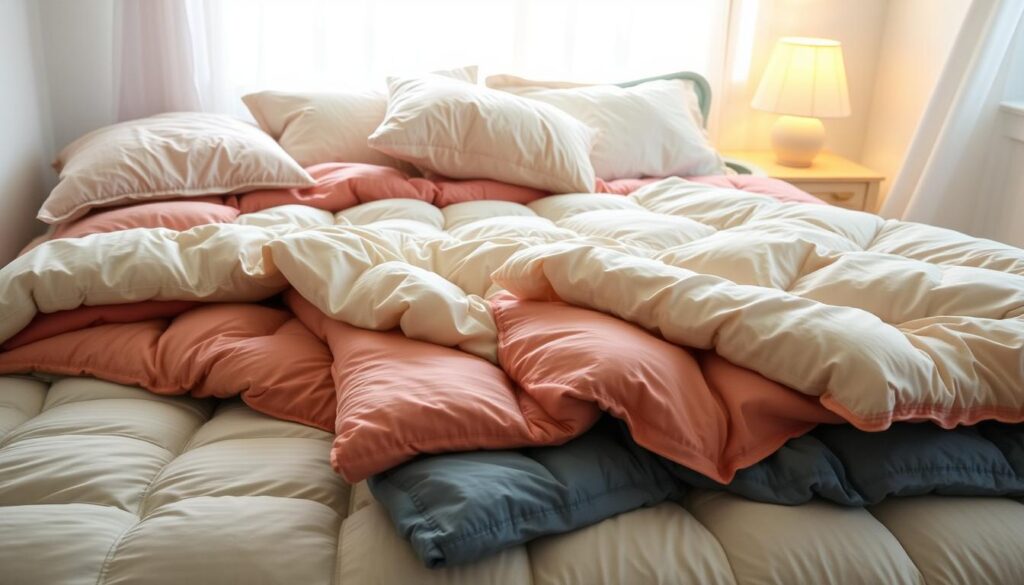
Choosing the Right Comforter Size
Choosing the right comforter size is key for a cozy bed. It should fit your mattress well and match your bedroom’s style. Our comforter size guide helps you pick the best one, from twin comforters to California king comforters.
Start by measuring your mattress. Note its length, width, and thickness. This info helps pick the right comforter size. For example, a twin comforter fits smaller beds, while a queen comforter is for larger ones. Think about whether you want the comforter to spill over the bed or stay neat.
| Mattress Size | Comforter Size |
|---|---|
| Twin | 66″ x 86″ |
| Twin XL | 66″ x 90″ |
| Full | 80″ x 86″ |
| Queen | 90″ x 90″ |
| King | 104″ x 90″ |
| California King | 110″ x 96″ |
For extra coverage, check out our oversized comforters. These comforters spill over the bed, adding a touch of luxury.
The best comforter size for you depends on your bed and what you like. Measure carefully and explore your options. This way, you’ll find the perfect comforter to make your bedroom cozy and inviting.
Different Types of Comforters Available
Choosing the right comforter can turn your bedroom into a cozy retreat. There’s more than just white comforters out there. You can find quilted comforters, organic comforters, and even reversible comforters to match your style.
Weighted comforters add a cozy, secure feel. For warmer months, summer comforters are light and cool. And year-round comforters adapt to every season, making them perfect for all-year use.
The fabric of your comforter also matters. You can choose from soft comforter fabrics like cotton and bamboo. Or go for durable blends that fit your bedroom’s style and your sleep needs.
| Comforter Type | Key Features | Best Suited For |
|---|---|---|
| Quilted Comforters | Stitched patterns for added texture and warmth | Year-round use, versatile aesthetic |
| Organic Comforters | Made with certified organic materials, eco-friendly | Environmentally conscious consumers |
| Reversible Comforters | Dual-sided design for a change of style | Those who enjoy versatility and options |
| Weighted Comforters | Provide a sense of comfort and security | Those seeking a cocooning sensation |
| Summer Comforters | Lightweight and breathable for warm weather | Hot sleepers or warm climates |
| Year-Round Comforters | Adaptable weight for changing seasons | Sleepers who want a single, versatile option |
With so many types of comforters available, you’re sure to find the perfect one. It will make your bedroom a cozy, comfortable haven.
Conclusion
Looking for the perfect comforter involves many factors. You need to know the difference between down and down alternative fillings. Also, understanding comforter construction and warmth levels is key. This guide has given you the info you need to make a smart choice.
Remember to measure your bed and think about your sleep preferences. Pick a comforter that looks good and feels right. It should keep you warm and comfortable for a good night’s sleep.
Whether you like the softness of a down comforter or the easy care of a down alternative, knowing the pros and cons is important. Also, learning how to properly wash a comforter can make it last longer. If you sleep hot, a lightweight comforter might be the best choice for you.
With what you’ve learned, you can now pick the right comforter. It will make your bedroom cozy and relaxing. Enjoy finding the perfect comforter for your bed and look forward to many good nights’ sleep.

